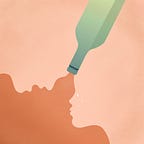The Simplest Photoshop Brush Tut Ever!
Having no understanding of how Photoshop’s brush settings work, is like cooking on a stove that offers no knob to adjust the size of the flame!
Are you saying to yourself, “why should I deal with the complexity of Photoshop brushes when Kyle T Webster has already made Gouache, Oils, Manga, etc., and they’re now shipped as defaults?” I felt that way too, but, I’ve seen the light thanks to previewing Chris Legaspi’s NMA course on Photoshop. If you’re still doubting the ROI consider:
- Do you paint? Have you ever thought “Gee, I’d really like a simple but flexible flat brush so I can just block in big areas quickly, and there are about a thousand brushes I have to look through to find this particular one—hrm, and it’s close but not quite exactly what I wanted :(“
- Do you envy the little rough edges your favorite illustrators achieve and have you wasted tons of time looking at tuts to figure out how to achieve that, just to feel like you’re not quite duplicating the edge texture you love?
Ok, hopefully I’ve got your interest. I should start by mentioning that a lot of this material assumes you have a tablet and Photoshop CC (your mileage may vary otherwise).
Let’s make a Flat Brush
All we’re doing today is to build a simple but useful flat brush, which is awesome for blocking in, doing value studies, thumbnails, etc. If you’ve done any real world painting, you’ll appreciate the usefulness of a good flat brush.
- Create a new document of any size but make it’s aspect ratio square e.g. 600px x 600px.
- Hit D to make the foreground color black and select Photoshop’s default Hard Round brush.
- Ensure the opacity and flow are at 100% in the top options bar.
- Open the Brush Settings either from Window-Brush Settings or similar:
- Now create a new layer, set the angle to 90º either by dragging the little arrow that’s at 3 o’clock initially (like in screen capture above), or, just entering it in to the Angle field.
Make the Roundness 18% or thereabouts by either dragging the roundness handles or entering in field and turn spacing to 1%. We should have something like this:
- Now if you make some strokes (like I did above), you should start to see we’re already pretty close already. But, try a vertical stroke this time and you’ll notice it’s thinner. Let’s fix that by setting Angle Jitter to Direction…
- With just that we’ve got a really nice flat brush, but we’ll make two of them so let’s save that by creating a new brush preset on the side flyout menu of the Brushes panel flyout menu like so:
- Name your brush Flat (or whatever) and accept the checkbox defaults. It’ll show up at the very bottom of your Brushes by the way.
- Now let’s make a second more textural version by simply adjusting the size jitter and setting it somewhere between 10–15%:
Ooo, it’s that nice fringe effect! Now save this as something like Flat Texture, and you have two really helpful flat brushes you can use for blocking in big shapes. Here’s what it looks like when you’ve selected New Brush Preset:
Fwiw, I blocked in most of the top illustration using this exact brush until I got to the detailed work and textural effects.
Without going in to details on saving brush presets, here’s a clue. In the brush panel you used to create the brush preset, the same flyout menu we’ve been using also has options to create a New Brush Group (a folder) and Export Selected Brushes. With those, you can create a folder for your brush set, and drag your brushes in to it, and then export them for later use. It’ll create an .abr file and you might want to back that up (I copy mine over to Dropbox from time to time).
Going Further
With the above experience of creating one simple but useful brush, you’ve sort of done the Hello World! of brush settings, but can now start to reverse engineer certain brushes you like to try to identify how they created the effect.
I’d encourage you to also take the default hard round and see what happens when you adjust various brush settings, like Brush Tip Shape—Spacing (clue: you should start to see polka dots), or Hardness (lowering should give a sort of airbrush edge). Play around and start to tweak some of the default brushes you already favor.
If I get feedback that it would be valuable, I could do another simple brush tutorial on creating textural or scatter brushes.
Rob Levin is a freelance illustrator. Portfolio: https://roblevin.myportfolio.com/ For illustration work enquiries, collaboration, or to say hi: roblevinillustration@gmail.com.
Also, you may like to read more of the illustration teardowns articles.
